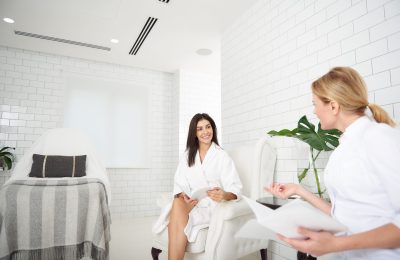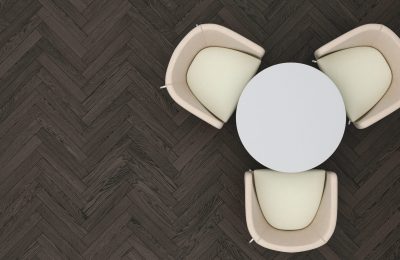In the spa industry, hiring the right employee always benefits owners By Brooke SmithFor employers, hiring a qualified employee can…
Men in robes
Lest you should think that spas are still the exclusive domain of women, a 2013 report commissioned by the International SPA Association Foundation (ISPA) found that men make up 47 per cent of spa-goers (defined as persons who have visited the spa at least once in the past 12 months) in the U.S.
Understanding the male spa-goer is one thing; retaining their loyalty is quite another. Here are some tips and tactics I’ve gleaned from the experts about how to get men into the spa and keep them there:
The New Normal
It’s all about normalizing the spa for male clients, says Laura Oleksow, Co-Owner of Spa 901 in Fernie, B.C. “I think in a lot of men’s minds the spa is a place for women… because typically it’s been marketed in that way, always very heavy on the esthetic side.” Part of the process of normalizing the spa for men involves adapting to their needs and desires. For example, Executive Vice-President of Cosmecor, Alain Leclerc, suggests masculinising areas of the spa designated for male clients. “I would say the Nordic spas in Quebec have done a good job of creating a locker room environment that sits well [with male clients],” Leclerc says. “They know they get a lot of traffic, so their locker room is well developed so that the men can relax before they get to their treatments.”
Leclerc says there aren’t many spas that have been designed with men in mind. He points to two examples in Montreal: Midtown Athletic Club, which has successfully combined the gym, a very masculine space, with the benefits of the spa. The other is Mantelier, which brings spa services like manicures, pedicures and facials (under titles like The Black Leather Shoe and The Handshake) into the traditional setting of the barbershop.
The Packaging
When it comes to marketing spa services and products to male clients, it helps to frame them in terms of masculine traits and activities. Sometimes that means giving spa treatments masculine-sounding names. Instead of using words like beauty to describe spa treatments, Leclerc suggests using words like sports and grooming. For example, Spa 901 recently updated its spa menu to include a male section, which highlighted services like the Sports Pedicure, the Masculine Manicure, and Manscaping. These treatments are specially tailored for the spa’s male clientele, Oleksow says, especially the Miner’s Tune-Up Facial, which was inspired by Fernie’s mining town identity and involves a charcoal mask. “We decided to put a male section on our menu because we wanted to build that side of our services,” Oleksow says. Before Spa 901 added the male section to its menu, men primarily came in for massages; now Oleksow says there has been an increase in men coming in for pedicures and manscaping. “It’s almost like putting it on the menu gave them validation that it was OK to come to the spa for other services other than massage,” she says.
“I think men in general, they want to take care of their skin and they know that it’s important, but I think relating it to shaving is always sort of a good starting point,” says Nicole Fisico, Managing Director of Spa Addiction and skin care brand Face Addiction. “For men that don’t necessarily consider using anything but soap on their skin, even to just suggest something as an aftershave balm definitely can make a huge difference.”
When developing treatment menus with spas specifically for men, Fisico says Spa Addiction will often repackage a facial as a pre-shave treatment and recommend that men come into the spa with a little stubble. “After your facial, the hair on the face will be nice and soft,” Fisico says. “It will give you a closer shave and prevent ingrown hairs.”
Plain Talk
When discussing the benefits of a particular spa treatment or product with male clients, it helps to be direct, Leclerc says. “[Men] need the comfort of understanding,” Leclerc says. “They need factual information.” When talking to male clients, one should use simple words and tell it like it is, so they don’t have to wonder what it is you are saying. Men are also very results-oriented, he says, so it helps to present them with solutions to any skin care issues they may have and to tell them plainly what a given product or spa treatment will do for them. Leclerc says modern male spa-goers are more open than ever to anti-aging treatments if they can be convinced of their benefits, especially if they are in the 40 years and older cohort. “They won’t be afraid to spend $140 or $150 for treatment,” Leclerc says of this age group, especially, he adds, if they believe the treatment will deliver the desired results.
Sometimes it helps to get men talking to other men about the benefits of the spa. Spa 901 employed that tactic when it invited Kevin Barnum to try out their new and improved male-focused treatments. Barnum later wrote a post on Facebook about his experiences and was able to recommend treatments for women looking to book their boyfriends and husbands into the spa.
The ISPA report on male spa-goers lists the expertise and credentials of spa therapists and staff as a factor in a man’s decision to visit a spa. Ultimately, the more information a male spa client is provided about spa treatments and products, the more likely he is to respond favourably. “I think it’s all about education,” Oleksow says. “The more they’re educated and the more they’re aware of the benefits, the more men we’ll ultimately see in the spa for those esthetic treatments.”
Getting men to see going to the spa and using spa products as a normal part of their lives takes time and depends on their level of comfort in the spa environment. When men start going to the spa, Leclerc says, the services they use will be quite limited. They may initially start with a massage, and then graduate to a body treatment and a facial. Once they get to that point, Leclerc says, men should follow the same trajectory as women. Once a spa has hooked a male client, it should be careful not to take him for granted, Leclerc cautions. “Once they have them, they need to nurture them very efficiently or else they will shop somewhere else,” he says. Unlike women, men are more likely to return to one or two spas where they felt comfortable, rather than shopping around, Leclerc says. “If you treat them well, they will come back, but if they feel something is not right, they will not come back.”
The Male Spa-Goer
According PwC’s 2013 “Consumer Snapshot – Volume IV: Male Consumer Insights” report, commissioned by the ISPA Foundation, the average male spa-goer is 25 to 44 years of age, has high levels of stress, and earns more than US$50,000. Male spa-goers are more likely than their non-spa attending counterparts to be physically active and health-conscious. They are particularly interested in spa treatments that are designed to relieve sore muscles and their most purchased retail items are shaving products, the report states. When male spa-goers were asked to identify factors that influenced their decision to visit a spa, the top three spa features they pointed to were:
- the cleanliness of the spa,
- spa amenities, and
- ambiance.



